1067 The uncertainty of Anne Carson
ESSAY: Anne Carson: Ambiguity, Uncertainty, Ecstasy
by Bob Foulkes
*
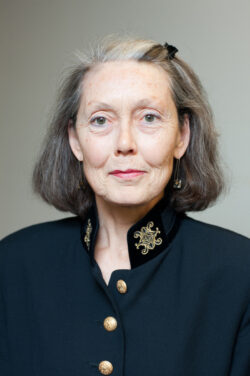
On an otherwise ordinary day in 1965, a precocious, eccentric fifteen year-old discovered a book in the sales bin of a Coles bookstore, a serious tome by Willis Barnstone on Sappho the famous ancient Greek poet. The book was bilingual — ancient Greek and English, a most unlikely find in a shopping mall in Hamilton, Ontario, a city better known for producing steel than sparking the career of a now-rumoured candidate for a Nobel prize in literature. Unlikely indeed.
To Anne Carson this chance event was a turning point in her life, her vivid and affectionate retelling acknowledged as her artistic epiphany.
Some twenty years later, Carson burst onto the intellectual, literary and academic scene with Eros the Bittersweet, a rewrite of her Doctoral thesis that became one of the 100 most important non-fiction books of all time, according to the 1999 list of the Modern Library.

At the age of 36, Anne Carson was poised to become a literary superstar. Almost unknown in Canada, she has since won every notable literary prize in the English-speaking world. Her extensive body of work defies precise classification or neat categorization, as does she: translator, cerebral academic, poet, author, visual artist, performance artist, wizard, enigma. Each one fits and none fully capture her complexity.
*
I discovered Anne Carson through Simon Fraser University’s Graduate Liberal Studies program, a Master’s degree in serious grappling with big, challenging, slippery ideas. The readings, the lectures, and the conversations with peers of diverse backgrounds pack a powerful, portentous punch. Too much for a rookie in the big ideas world, I gasped when invited to grasp the complexities and ambiguities of the syllabus, of which Anne Carson was but one name.
Once, asked what I was getting for my money as a late-blooming student, I could only offer one word — uncertainty. New ideas, strange intellectual terrain, and an unfamiliar lexicon spawned uncertainty about my beliefs, my judgement, my vision. I was forced out of my comfortable rut, I doubted what used to be rock solid, nuance ran rampant, and my clarity clouded. Coherence was sacrificed, there were too many options, black and white became shades of grey.
Ambiguity and uncertainty : there is no “there” there, there are many theres and they’re nowhere and everywhere. Anne Carson personifies that ambiguity and uncertainty; she raises more questions than answers.
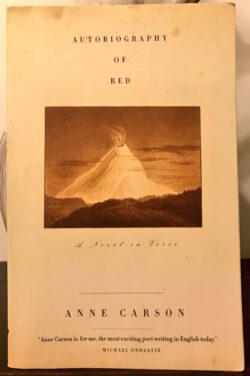
My Carson-awareness started with Autobiography of Red. Red mesmerized, mystified, and madly confused me. I couldn’t put it down. I had to put it down. I read a few pages, I needed a break; I prowled my apartment restlessly to slow the buzz in my head. It was incendiary yet addictive. Class discussion and subsequent re-reads did not cut through the fog of ambiguity and uncertainty she gifted me. Margaret Atwood said it all: “I don’t understand a word of this so it must be good.”[1]
I knew instantly, like Atwood, that Carson was brilliant, complex, an enigma, a puzzle, a wizard. I needed to know more about her, if for no other reason than to restore my equilibrium.[2] I’ve always written, mostly for a living. How did she end up writing award-winning poetry while I laboured to churn out crisp two-page memos and precise press releases for oil companies? Envy/admiration, compare/contrast, nature/nurture — who knows why she was so different from me and so fascinating? We all love a good puzzle.
*
Literary biographers have been worrying the famous forever. What started as hagiography became ennobled as history. Social scientists got into the game, hoping that dissecting the famous might offer clues to similar success for mere mortals. Researchers now parse through the flotsam and jetsam of people’s lives looking for those clues, a pursuit that has become its own genre, a cottage industry of conjecture.
Margaret Atwood, herself the object of much invasive speculation, offers a cautionary tale to anyone attempting to make sense of poets and other luminaries:
[I]f you write a work of fiction, everyone assumes that the people and events in it are disguised biography — but if you write your biography, it’s assumed you’re lying your head off .… I am a poet, and I affirm that that is true. About no subject are poets tempted to lie so much as about their own lives.[3]

Carson, like most authors, mines her life experiences for her most successful work. She has left many trails of crumbs for those wanting to sleuth the real Carson, hints and allusions and odd references abound in her work, and the seekers and soothsayers have a rich assay of ore to mine to refine her essence. Deliberately unpredictable, sometimes impenetrable, her work opens opportunities for interpretation and mis-interpretation. Such sleuthing is an uncertain business, far above my skill level. I’m more likely to find fool’s gold than the real thing. I don’t trust my ability to Sherlock her works.
I prefer to go directly to the source, to find Anne Carson’s own words explaining Anne Carson. First person singular seems more direct; listen to what she says, read the interviews, read the black part of the page. We work with the best tools at hand.
It is a task. Carson’s book jacket blurb is almost laughably short. “Anne Carson was born in Canada and teaches ancient Greek for a living” is arguably the shortest author biography ever constructed. There is never a back-cover photo. She’s a publicist’s nightmare.
Yet, there are interviews, sometimes surprisingly candid. She does not think highly of interviews; she has called them “useless,” gives them reluctantly, often responds only by email, answers questions monosyllabically or with her own question as a reply. Her own words are sometimes challenging to interpret, but at least they are her words. Carson doesn’t lie but she certainly doesn’t help; she doesn’t expose her true self with neon signs lighting the way. She seems to find safety in deliberate obfuscation, provocative obscurity, and limited exposure. As a master of words, she can generate just the right amount of fog.
One can safely say that the possibility of lying doesn’t end with the poet. I can try to read her words faithfully, try to interpret and intuit her work honestly. It also seems probable that I am an unindicted co-conspirator in the lying process. I have been known to misinterpret. No researcher or biographer can deliver on a claim to objectivity or a commitment to tell the truth. I have my own agenda, my own lies to tell. There’s bound to be some lying going on.
*
Discovering the Greek book in the discount bin needed a sprinkle of luck, kismet, serendipity, Karma, fate, an Act of God or acts of gods; whatever we call it, a catalyst was necessary to activate the epiphany. The catalyst was Alice Cowan.
Carson’s father was a bank manager. Bank policy required the family move every three years to new towns. Bankers weren’t to get too cozy with the townsfolk — it might affect their lending decisions.
The year Carson discovered her Sappho book, she moved from Hamilton to Port Hope. In this new school, her last year of high school, she met Alice Cowan, the Latin teacher at the Port Hope high school. Latin was a required part of the curriculum in Ontario at the time. Carson had studied Latin but now she had this new book in ancient Greek and it had captivated her. Cowan heard of her interest in Greek and, a Greek language enthusiast as well, she schooled Anne in Greek on lunch hour throughout her final year.
Cowan is a vital component of Carson’s transformational event story. “Had I not met Mrs. Cowan, I just wouldn’t be me,” she gushed in one interview.[4] In another: “I owe my career and happiness to Alice Cowan in Port Hope high school.”[5]
*
I’m fascinated with Anne Carson for many reasons. Her creativity, her bravery, her energy, her fierce individualism and subtle wit were blindingly obvious when I discovered Autobiography of Red. She seemed to embody what I had always admired and sometimes aspired to be, but had not attempted, much less achieved. There is a cognitive dissonance to her work. I don’t like the uncertainty. Her work is puzzling and deliberately sows uncertainty. She is ambiguous while I desire clarity. Her writing requires close reading. It must be interpreted, and it is easily misinterpreted. In my own writing I have striven to communicate clearly to eliminate misunderstanding. She creates a fog of possibilities: I want only one.
My academic leap into the unknown offered constant uncertainty. Perhaps I desired a solution. Understanding Anne Carson might offer clarity, diminish my bafflement, provide more of the certainty I craved. I doubted I could solve the puzzle of her or her work; but that’s not the point, aren’t we all looking more to solve our own puzzles?
We do have some things in common. Carson and I are Canadians, almost the same age, and come from small towns, but that’s just serendipity. The notion that I am seeking in Anne Carson the clue to finding the Holy Grail or divining the secret to her success so that I can become her equal — that is not on my mind. That ambition-fuelled train left the station decades ago.
Carson is interesting. Maybe it’s the thrill of uncertainty, an awakened desire for my own epiphany, or simply a justification for buying more of Carson’s books that attracts me to her work.
*
Anne Carson is also dazzling. These days we call rare individuals like her gifted. In the sixties the category and the words we used to define giftedness had not yet been invented — smart, strange, different, even genius, but rarely gifted; the lexicon didn’t yet exist. I’m not alone in recognizing her giftedness. The MacArthur Foundation has a grant program called the MacArthur Genius Grant; in 2000 they awarded Carson more than $600,000, no strings attached, to pursue her fancy, and, coincidentally, certified her to the world as a genuine genius.
When Carson and I were growing up, someone smart got bumped up a grade or two, but even so, some were perpetually restless and bored. A few good teachers, like Mrs. Cowan if one was lucky, tried to find ways to amuse them; most teachers didn’t know enough to try. Decades later, we knew more and cared more; my own children were tested, and because the school board was progressive and had a budget, streamed into a special program in a separate school with their gifted peers. Giftedness is now recognized. It is now seen as both a blessing and a burden, and which way the scales tip is known to have profound consequences.
The gifted are different. They know they are, even if they, and we, don’t understand why. We are all uncertain about what to do about it. Carson’s gifts made her different, and she faced a challenging navigation through formative years filled with being different — replete with ambiguity and uncertainty.
*
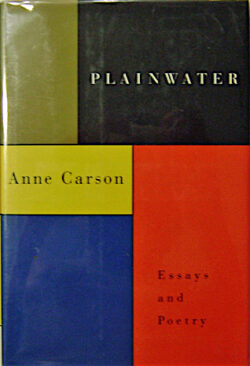
I can add my simple affirmation of the MacArthur designation of Carson as gifted, as a “genius.” The second book of Carson’s I read was by chance. Having become enthralled by The Autobiography of Red, I found Plainwater while sleuthing for more of Carson in my favourite used bookstore. Published in 1995, it is a remarkable book, almost diary-like, and seems achingly personal, a deeply revealing autobiographical insight into a Carson who is still very uncertain about an issue of profound importance to her — love. Many regard it as a lament for an eight-year marriage that ended badly in 1980, and Carson herself writes:
Love is, as you know, a harrowing event. I believed in taking an anthropological approach to that. Even now, it is hard to admit how love knocked me over. I had lived a life protected from all surprise, now suddenly I was a wheel running downhill, a light thrown against a wall, paper blown flat in the ditch. I was outside my own language and customs.[6]
A long prose-poem in her book, The Anthology of Water, is Carson’s vivid story of romantic uncertainty. Like sticking my finger back into a wall outlet, I was as electrified again. It is startlingly introspective, evocative, and personal. She starts with a bang: “Water is something you cannot hold. Like men. I have tried. Father, brother, lover, true friends, hungry ghosts and God, one by one all took themselves out of my hands.”[7] Captivated yet again, I dove in, trying again to solve Carson.
Carson recounts her pilgrimage of the Camino de Santiago from Saint Jean Pied du Port to Santiago and a further step to Finisterre — the end of the world, the furthest western point of Europe.
I was thrilled; in 2013, I walked exactly the same route. We had something concrete to share besides being small-town Canadians of the same age. We had trodden the same physical space!
It’s clear that I did my pilgrimage on a different planet or a maybe in a different far-off galaxy.
My trek was simple. I walked, I slept, I ate, I met other pilgrims, I thought a lot. Travelling alone for such a long time, I learned to be more comfortable in my own skin, to be more at peace with myself, my past and my memories, more comfortable with my future. As for epiphanies, it is probably oxymoronic to describe mine as a small gradual one, providing no blinding flashes of the obvious or of any other sort, but a slow and growing satisfaction that comes from accomplishing a challenge one is uncertain one can meet. I also learned to travel light: over the 800 or so kilometres of walking I discarded half of the weight of my backpack, which I conveniently left behind at Albergues along the way.
Carson had another pilgrimage altogether. She travelled with a companion she named him “El Cid;” she walked at about my pace; she stopped at many of the villages, towns, cities and other oases I remember; and she experienced age-old pilgrim struggles with fatigue, hunger, and road-weariness.
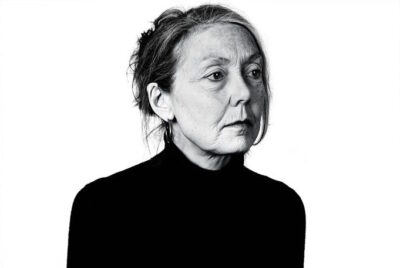
Her pilgrimage was so much more profound. She lightened her load too, but while I dropped physical baggage, she dropped heavy emotional baggage — the deaths of her father, the worn ennui of a failed marriage, the loss of her brother and other romantic estrangements — in the process experiencing a growth and a serenity worthy of such a pilgrimage. Each day’s entry in her journal began with a quote, most of them haiku-like in their impenetrability. Carson’s own entries contained deep, profound questions — while my logs were shamefully mundane, for example whether to have the local frittata or the chicken leg for my dinner.
She was searching for the key to the mystery of love, which is startling because she seemed to have decisively untangled that knot in Eros the Bittersweet and other poems, yet here she was in her Pilgrim frame of mind: “Love is a mystery inside this walking. It runs ahead of us like a dog….”[8]
She may have lightened her emotional load but the longing and the loneliness became heavier, more burdensome, and as she and El Cid approach Santiago, anger and conflict dot the trail. She ends where she started: “Pilgrims were people who carried little. They carried it balanced on their heart.”[9]
The overarching truism of pilgrimages is that we each experience our own pilgrimage. Nothing could be truer if Carson and I stand side by side, yet as I read her, one matter is clear: she is gifted beyond measure. To paraphrase another judge, I may not know what genius is, but I know it when I see it.
*
Carson exhibited her uniqueness in deeply personal ways. In her teen years she felt she was the reincarnation of Oscar Wilde. She recalls attending parties dressed as Wilde, an action more daring than putting on the occasional Halloween costume.
How does someone who is 15 even know of Oscar Wilde? It was the mid 1960s! The rest of us were worried about making the team, fitting in, whether we’d have a date for the school dance, whether the zits would ever go away. We were a raging hormonal stew. There was a lot of stuff going on – and we don’t have time to find Wilde.
Amidst all this she discovered and embraced Oscar Wilde? Wilde, she wrote, “… was classically educated, elegantly dressed, publicly witty …. I did feel that it gave me an education in aesthetic sensibility, and also a kind of irony toward myself that was useful in later life.”[10]
Most interviewers use Wilde to launch a not-so-subtle probe into her ambiguity about gender identity. Fishing for uncertainty and angst, they find little. Carson is unambiguous about her ambiguity:
I guess I’ve never felt entirely female, but then probably lots of people don’t. But I think that at different times in my life I located myself in different places on the gender spectrum…. I wouldn’t say I exactly felt like a man, but when you’re talking about yourself you only have these two options. There’s no word for the “floating” gender in which we would all like to rest. The neuter gender comes up in the unbearable poem, but that doesn’t really capture it because you don’t feel neuter, you feel just wrong. Wrong vis-a-vis the gender you’re supposed to be, wrong vis-a-vis the other one, and so what are you?[11]
*
I can’t profess an empathy that requires a level of shared experience. I can only imagine the level of uncertainty that existed as she navigated her teen years. She dressed as Oscar Wilde — in public no less. My own teen response was to do whatever was required to fit in. I bought the uniform: jeans, a crisp shirt, the school team jersey. As for gender ambiguity, I grew up in a small town in Alberta, a different planet completely that distorts my capacity to sympathize or empathize. Again, Carson’s resilience and confidence seemed to conquer any uncertainty about whatever ambiguity she experienced.
*
Opportunities for greater uncertainty and ambiguity grew. Her father’s career-driven moves meant that her life and friendships were transitory, as she wrote:
Which I do believe added to my survival skills. I remember thinking one day as we were pulling out of the driveway, as I was waving good-bye to my best friends, whom I would never see again…. At least half of your mind is always thinking, I’ll be leaving; this won’t last. It’s a good Buddhist attitude. If I were a Buddhist, this would be a great help. As it is, I’m just sad.[12]
Carson’s family experience offered potential for further ambiguity and uncertainty. Her father was taciturn. She remarked once in an interview that she never talked to him in any meaningful way: “We were very amiable, we liked each other. We had the same jokes…. We were very friendly but just totally terrified of talking about anything real.”[13]
She describes her mother as an intelligent but frustrated intellectual who had sacrificed her dreams of an independent career. She was “Very Clever — in high school she won the Latin medal in her graduating class and could have gone on to university but had to go to work …. She was a little lonely for the person she would have been if she’d had a different fate.”[14]
As to their relationship, Carson says, “We were like two islands that recognize each other but don’t touch.”[15] The loss of both her father and her brother finally brought her and her mother closer. “Not the same kind of people, but we got close. As others were gradually pared away, we came to be close.”[16]
Her only sibling, her older brother, was a challenge: rebellious, frustrated, and distant.

*
Gifted intellect, eclectic interests, energy, Oscar Wilde persona, gender fluidity, no lasting friends, a nuclear family constipated by lack of intimacy: this was the life of teenaged Anne Carson. Ambiguity and uncertainty are the only common threads I can find that might weave through them all, or offer an insight.
This combination was foreign to me; I was none of those. I was somewhat quicker than others in school but my only challenge was excessive boredom and camouflaging my learning quickness. I made a few tentative steps beyond the conventional. Joining Air Cadets wasn’t as exotic as channeling Oscar Wilde and my uniform/costume didn’t raise any eyebrows. My only gender challenge was a teenage boy’s uncertain obsession with wanting girls to like him and too much warped John Wayne/ James Bond-from-the-movies manhood ideation.
Most of my excessive energy was funnelled into part-time jobs to buy some pocket-change independence from a parental allowance. I had a constant group of friends, and growing up together in a tight little neighbourhood we bonded tightly. Our community was the proverbial village; my mother’s friends, who watched everyone in the street and reported back, proved effective at ratting out any teenage indiscretions. It wasn’t the Stasi I had to deal with, but it worked. I survived one move in the first 18 years of my life in a small prairie town: we moved one block.
I lived in a large family with a hard-working, diligent, taciturn father and a constantly-in-motion, human dynamo mother and three siblings, all mixing it up in a very small house. A free-range teen, I learned to evade the spying and prying neighbours and amused myself without getting into too much trouble.
That was my life. I’m not sure if I should benchmark Anne Carson against my white-bread existence — or measure myself against her eclectic and ever-changing circumstances. In the important stuff it seems we shared little in common in our growing up years. Carson and I could not have been more estranged.
*
At 16, Carson fell in love with the ancient Greek language, with the puzzle it provided, with the challenge of solving that puzzle, with the doorway it opened to a more complex view of love, language, and life. It became her life-long passion, informed her creative vision, and complemented her life of ambiguity and uncertainty. It seemed to enervate her.
She explained her attraction to the study of ancient Greek:
It’s like a language from outer space. It’s a marvellous supple and original grammar, it has an aura that the language has even for people who know it very well, it never goes away. There is a kind of a whiff of the primordial thought in Greek words that isn’t in other words, even in Latin.[17]
And in a further elaboration she explains:
Looking at the gaps between the words as you move from one language to another, and the way meaning disappears into the gaps — that experience is what I value most about translation. We operate all the time with language as if it says what we mean. It never does, but you don’t realize the flaccidity of that until you are actually trying to make one thing in one language into another language. It’s like being on a surface with a lot of cracks in it and looking down through the cracks to something like another world down there that you can almost see, almost express, but not quite. It’s frustrating in the sense that there’s an ideal understanding down there that’s not available but, on the other hand, it doubles reality because we don’t live in that ideal world, we live up here, and yet you can glimpse down through the cracks to that other thing…. the Greeks are really different. There is otherness, they are not us….[18]
Carson came to understand and embrace the translator’s reality that there is no ideal, no Rosetta Stone, no perfect English translation of ancient Greek. Comfortable already with uncertainty, Carson seems unfazed by the multiplicity of choices, the plethora of options, the ambiguity. Rather than an impediment, ambiguity was the perfect puzzle for her curiosity, the perfect outlet for her restlessness, and a respite from her perpetual boredom.
*
My personal passion arrived a bit later, 1968 to be exact. I fell in love with politics, having spent my university years learning that I didn’t want to be an engineer and enjoying my freedom as a small-town kid in the big city. Politics offered a similar ambiguity, infinite possibilities, no clear answers, and an ever-changing set of parameters. Besides, being a Liberal in Alberta was somewhat like choosing to be James Dean, a rebel … but I was a safe one: no motorcycle for me because everybody knows how dangerous they are.
Maybe Anne Carson and I are getting somewhere: we share a found passion. My Engineering School academic advisor and I agreed that my future did not lie in building bridges — at least not the concrete and metal kind. I jumped right into my passion: campaigning, arguing, staying up late, discovering the infinite possibilities that come from trying to command the human condition and convince people to join my cause de jour. I didn’t buy Che’s dark beret and attend anti-Vietnam War rallies, but I took every course related to politics I could find.
Federal politics became my puzzle, infinitely interesting, never boring, constantly changing, and demanding of my energy. It was my Ancient Greek, feeding my passion for worrying an unsolvable puzzle. I faced and embraced uncertainty and ambiguity – a parallel that offers a small insight into Carson’s passion for Greek.
*
Sappho’s works are mostly fragments. There are gaps, an unfinished yet enticing phrase, lost words forever destroyed, bits lifted from an aged crackled papyrus – they all radiate uncertainty by offering no clues and infinite possibilities. Carson’s task was to translate what was there but, her curiosity being what it was, she would speculate over the missing word, the incomplete phrase:
There is a space where a thought would be, but which you can’t get hold of. I love that space … no matter what the thought would be if it were fully worked out, it wouldn’t be as good as the suggestion of a thought that the space gives you. Nothing worked out could be so arresting, so spooky.[19]
Ancient Greek also tickled Carson’s first creative love, drawing. “The physicality of ancient poetry (transmitted by the mystique of the fragment) fitted easily into this aesthetic, and Greek letters themselves, the first time I saw them seemed to me fantastic drawings.”[20]
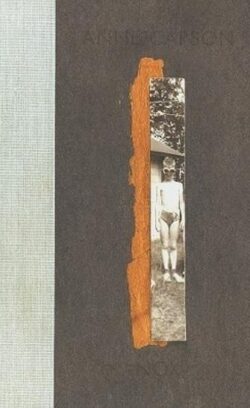
From an early age, she drew before, almost as an afterthought, attaching captions to her evocative drawings. Her audience praised her words not her pictures. She followed the praise but never lost her love of the visual, and indeed she sees herself as a visual artist first:
I think of making a poem as making an object. I’ve always thought of them as more of drawings than as texts but drawings that are also physically enterable through the fact of language. I wouldn’t know of another way to think of a book except as an object that is as visually real as it is textually real.[21]
Carson’s work accentuates her visual focus. She has consistently broken boundaries to present her work in visually arresting styles. Her most powerful and innovative visual statement is Nox, her search for meaning in her almost non-existent relationship with her brother. What made it outstanding was her packaging of this elegy-eulogy in a ten-foot-long accordion-folded single-sheet page that becomes a book, mashing together a short poem by Catullus, the Roman poet, and her anguished search for meaning, her depth of feeling that overcomes the dearth of text, oddly emphasizing how ephemeral their relationship was.
Anne Carson does not draw within the lines.
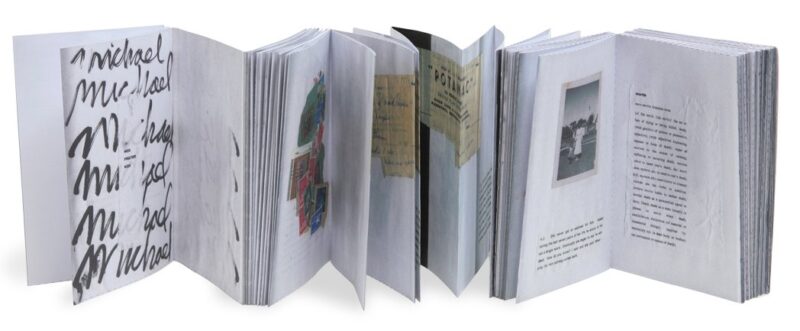
*
The sensitive translation of ancient Greek to English strikes me as a key to unlocking Carson’s brilliant creativity. Translation of ancient Greek is her puzzle, not only in finding the right words, but finding word combinations that best represent the intuitive feeling the translator has for the piece. This task is made more challenging by structural constraints. Greek poetry had developed conventions; and trying to match those conventions, to honour the rules of style, sound, rhythm, and spacing while reflecting the vitality and emotional resonance, is an insurmountable task for a translator. Carson became a word wizard, a living thesaurus of nuance and subtlety, a seeker of truth in metaphor, infinitives, participles, adjectives and adverbs, alliteration and syntax.
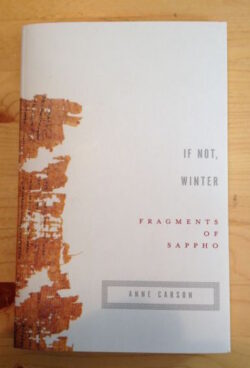
And there were the gaps. In If Not, Winter, she placed the complete set of Sappho’s known work in the original Greek on facing pages with her translation, an homage to and an echo of her first Sappho book found so many years before. The gaps are starkly visual and obvious; one wants to run screaming from the task; there are more gaps than words. She persisted and persevered to produce a luminous exemplary of the complex, always-imperfect mastery of translation, interpretation, mood, and rhythm. Undoubtedly she is a wizard of words.
“I will do anything to avoid boredom,…” she has said. “It is the task of a lifetime. You can never know enough, never work enough, never use the infinitives and participles oddly enough, never impede the movement harshly enough, never leave the mind quickly enough.”[22]
She had made her escape from a lifetime of boredom.
*
Her linguistic dexterity, this capacity to choose just the right word, this playing with infinite combinations of nuance became a platform for her personal flights of creativity. That is why Autobiography of Red was such a burst of fireworks sparked by her audacious use of words.
I have written for a living; my patronage not my passion has been the driving force. Married at 22, a first child at 25, another at 30, I found a lucrative outlet for my journeyman skills in crafting speeches for the almost-famous, in constructing clear, crisp memos outlining options for decision by others, in turning financial figures into readable, unambiguous prose. These all paid well and offered advancement and status. A small-town boy had Peter-Panned his way into a career. It imbued in me a love of words, especially their precision.
My words aimed for clarity, certainty, unambiguous comprehension, black and white understanding. Carson offers none of those. Instead, every turn of phrase is a firecracker. She litters every page with tiny surprises that explode when my eyes and my mind set them off.
Words were my bricks and mortar. I was, and still am, proud of them, but they are not the rich, dense, lush, provocative, imagination stimulators of Anne Carson’s words.
The magic of Carson is to show us — okay, me — that what we do for a living may not be all that we long for. In this she is inspirational. I do not need to be baited into the aspirational; I can just admire without trying to emulate. There is much to admire. At my stage of life envy is not a burden I care to shoulder.
*
Anne Carson seems to emerge from all these uncertainties without sadness or resentment at her social and emotional dislocation. With confidence in her uniqueness, she seems somehow to have been energized by her life experiences. Some might have buckled under the weight of bearing life’s ambiguities and uncertainties, some might have pulled back into their shell and never come out as a reaction to feeling different and uncertain, and estranged from deep relationships with friends and family; some might have become perpetual outsiders; some might have shrivelled from a society that only allows a rigid definition of gender; but Carson blossomed. She seemed to channel this uncertainty and ambiguity into creativity, lateral thinking, providing the freedom to break out of the forced rigidity of labels.
She could have resented a father who forced her to move constantly and who seldom communicated except through his mindless, almost moronic attempts at jokes. Yet one of my favourite Carson poems is a loving, poignant homage to her father:
Father’s Old Blue Cardigan
Now it hangs on the back of the kitchen chair
where I always sit, as it did
on the back of the kitchen chair where he always sat.
I put it on whenever I come in,
as he did, stamping
the snow from his boots.
I put it on and sit in the dark.
He would not have done this.
Coldness comes paring down from the moonbone in the sky.
His laws were a secret.
But I remember the moment at which I knew
he was going mad inside his laws.
He was standing at the turn of the driveway when I arrived.
He had on the blue cardigan with the buttons done up all the way to the top.
Not only because it was a hot July afternoon
but the look on his face —
as a small child who has been dressed by some aunt early in the morning
for a long trip
on cold trains and windy platforms
will sit very straight at the edge of his seat
while the shadows like long fingers
over the haystacks that sweep past
keep shocking him
because he is riding backwards.[23]
She still wears that old blue cardigan and mentions it affectionately when asked about her father. Like Nox, her ode to her lost brother, Carson has been publicly, remarkably forgiving to her family.
True to her dedication to Oscar Wilde, she still manages to dress in her “Oscar Wilde suit:” slim plaid pants, a long dark coat with white stitching on the lapels, and a bright red necktie featuring a picture of Geryon, her protagonist in Autobiography of Red. She is adamant in not giving up on her long desire to be Oscar Wilde because, in her words, “it’s unachieved, as yet.”[24]
She has a stable relationship of some 20 years with her second husband and co-collaborator, Robert Currie. She affectionately calls him the Randomizer.
It seems she has a gift for gaining strength, steely individualism, the courage to be different, and inspiration from the ambiguity and uncertainty of her formative years.
She first channeled that gift into the study of ancient Greek as a translator, and she could have spent the rest of her life teasing her solutions to those insolubles. Uniquely, she mastered the inherent uncertainty of translation, embraced it, channeled it, used it as a way to master the complexities and infinite possibilities of words. In this way her comfort with uncertainty energized her creativity and individuality, opened up possibilities. Sappho, ancient Greek, and Mrs. Cowan were her muses, her own personal gateway to a lifetime of passionate fulfillment. Interpreter, academic, artist, poet, writer, performance artist, twister of ideas, she keeps exploring, pushing boundaries.
Carson defies typecasting, labels, categorization, marginalization. “You don’t know how to be yourself as a part of a category, so you just have to be yourself as a completely strange individual and fight off any attempt others make to define you.”[25]
She loves to mash two distinct ideas together to see what happens: “The things you think of to link are not in your control. It’s just who you are, bumping into the world. But how you link them is what shows the nature of your mind. Individuality resides in the way links are made.”[26]
Carson doesn’t take herself too seriously: “I mean, most of us, to be honest, are just a collection of bits that don’t make sense. It’s a nice idea that there’s a coherent self in each of us with a story that another person could tell but it’s a fiction.”[27]
For those of us who try to read the signs and portents like some ancient soothsayer, to try to make some coherent whole of the lives of others and therefore by extension our own lives, she offers little comfort, but instead mostly a prescription of cosmic-sized messiness. Carson’s serious caution to all who seek a neatly packaged truth is that there isn’t one.
I can’t turn Anne Carson into an intelligible story with a narrative arc or a jigsaw that can be assembled to give a single clear picture. So we are left with reflective bits in the shards of her work — not a full comprehensive or comprehensible mirror image. That metaphor works, but, better, she seems more a kaleidoscope; shake her up, look in the aperture, and you see her differently: each time a new Anne Carson appears.
Carson offers solace when she invokes Herodotus, the first historian:
He has a good sense of humour, Herodotus. But I think he’s not kidding. He does hand over opinions, as well as facts, and he doesn’t try to distinguish too much among opinions as to the good ones and the bad ones. He trusts the reader to do that. An admirable tolerance. I think … in everything I write, there is an attempt at tolerance, to put down as much as I can figure out and let the reader make what sense they make.[28]
*
Carson creates uncertainty in me. As I age, I am prone to what is called hardening of the attitudes. It’s hard to reconcile my desire for neat order and full predictability with ambiguity. It’s hard to be comfortable with uncertainty. It’s hard to be perpetually doubtful. It’s not my preferred option, my safe, predictable, and understandable world. Bertrand Russell said it best: “One of the painful things about our time is that those who feel certainty are stupid, and those with any imagination and understanding are filled with doubt and indecision.”[29]
Is it that uncertainty that confirms we are not stupid?
When I read Anne Carson, I am uncertain as to her intent and her meaning. I always suspect that I have missed another, a hidden meaning. Carson seems comfortable with uncertainty; me, not so much. She has managed uncertainty by turning it from a potentially crippling impediment into an opportunity. Uncertainty opens the door to multiple possibilities. Choose one; they’re all interesting. She revels in defying labels, mashing things up, testing credulity, ignoring limits, crossing boundaries.
In Eros, the Bittersweet, she forces me to look at the sweet-bitter pathos of longing through the triangulation of Eros, me, and the object of my affection: “you desire the one you’ve invented rather than the one who exists.”[30]
In the same book, she grapples with Plato’s challenge of putting ideas on paper — does it freeze them in time, offering no opportunity for growth or improvement in future iterations? As she puts it, “The Phaedrus is a written dialogue that ends by discrediting written dialogues.”[31] To say she is bold and to the point is to understate both: she is succinct and direct.
She reimagines the Greek myth of Geryon and Herakles to come up with the unlikely and somewhat discordant transformation of Geryon, a retelling that is the genius of Autobiography of Red.
She mashes together experimental art and an obscure Roman poet to comprehend her grief and sadness over her brother’s estrangement and death and creates Nox, which was best described as “a luminous, big, shivering, discandied, unrepentant, barking web of an elegy, which is why it evokes so effectively the felt chaos and unreality of loss.”[32]
She walks the Camino and creates a narrative allegory to the men in her life: tragedy and comedy on the ancient pilgrim path to Santiago.
It goes on. The only consistency in Carson is the inconsistency. The only certainty is the uncertainty she conjures. We are forced off our equilibrium and our complacency, out of our ruts. She forces me to examine my certitude, to be doubtful, to open my eyes to other possibilities, to recognize that I don’t know and that there’s more to learn. She has forced doubt and uncertainty back into my mind and my life. She offers ambiguity as a doorway to consideration of wider possibilities. In all this she is worthy of emulation as she makes this quest for understanding more than worthwhile.
*
The final word is Anne’s (I feel I can call her by her first name now):
…What’s entrancing about the Greeks is that you get little glimpses of similarity, embedded in unbelievable otherness, in this huge landscape of strange convictions about the world and reactions to life that make no sense at all…. One thing I do understand about the Greeks is that they, too, understood otherness and valued it … the principle of being up against something so other that it bounces you out of yourself to a place where, nonetheless, you are still in yourself; there’s a connection to yourself as another. It’s what they call ecstasy….[33]
*
A funny thing happened while I was driving through Alberta, my home when I was growing up and, later, when my children were growing up. I’m not a big fan of country music but it’s what I play on Alberta road trips.
One of the songs on my playlist was Someday Soon by Ian Tyson, a real Alberta cowboy. My choice is a 1968 cover of the song by Judy Collins in which she perfectly captures the longing and heartbreak.
It’s a simple song: a girl has fallen in love with a cowboy who “loves his damned old rodeo as much as he loves me.” She is in the sweet part of the relationship: she loves him or, more accurately, she loves her idealized version of him.
All those around her know it’s going to end badly: “my parents cannot stand him ‘cause he rides the rodeo, my father says that he’ll leave my cryin.’” But she’s adamant: “I will follow him right down the toughest road I know, someday soon, goin’ with him someday soon.”[34]
Of all the sad country songs it’s my favourite and, as I’m driving along, I suddenly have a lightbulb moment, a powerful sense of deja vu. I’ve been here before. But where?
Then it strikes me. It’s Anne Carson writing about love in Eros the Bittersweet: the mournful combination of the sweet and bitter, the triangulation of the girl, Eros the idealized version of her love and the boy as he is. It’s the longing, the sweet enchantment of possibility, the intimation of bitter destiny.
I’m pretty sure Ian Tyson never read Sappho, much less Carson; but I get it, a connection that spans some 2,500 years, explaining the tear that forms in the corner of my eye.
I’m elated! I’m not a maudlin country buffoon. This song has deeper meaning.
Carson connects me to my longing, gifted across the ages by Sappho herself. Sappho, the ancient Greek poet of 2,000 years ago, now joins hands with Anne, Anne takes my hand, I grasp the rough calloused hand of Ian Tyson, and we form a chain. Joined, we share a transcendent instant, a deeper understanding of the immutability of love and life across the ages. I now know what that brief intense feeling was: Anne tells me it is what the ancient Greeks called ecstasy.
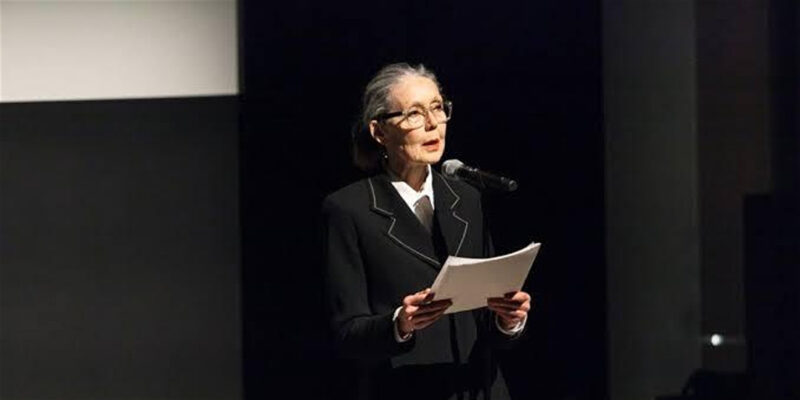
*
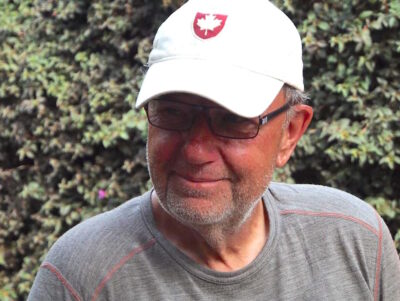
The Graduate Liberal Studies program at SFU has become Bob Foulkes’s latest adventure and self-administered antidote to the perils of the pandemic lockdown. He is a retired business executive, running away from boredom and restlessness and making up for lost time by stuffing as many adventures into his awake time as possible. He has written two books, Adventures with Knives, chronicling his attempt at culinary education at Granville Island’s Pacific Institute of Culinary Arts, and Off the Couch and Out the Door, a story of travel adventures and misadventures. He now blogs intermittently. Editor’s note: Bob Foulkes has also contributed “Letters from the Pandemic 4: Dear Diary” to The Ormsby Review.
*
The Ormsby Review. More Books. More Reviews. More Often.
Publisher and Editor: Richard Mackie
The Ormsby Review is a journal service for in-depth coverage of B.C. books and authors. The Advisory Board consists of Jean Barman, Wade Davis, Robin Fisher, Cole Harris, Hugh Johnston, Patricia Roy, David Stouck, Maria Tippett, and Graeme Wynn. Scholarly Patron: SFU Graduate Liberal Studies. Honorary Patron: Yosef Wosk. Provincial Government Patron since September 2018: Creative BC
“Only connect.” – E.M. Forster
Endnotes:
[1] Margaret Atwood, “Under the Thumb,” UTNE Reader (September-October 1996)
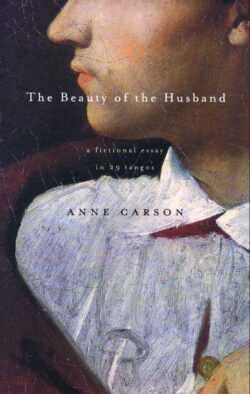
[2] In the preparation of this essay I consulted much of Anne Carson’s published work, including Eros the Bittersweet (Funks Grove, IL: Dalkey Archive Press, 1986); Glass, Irony, and God (New Work: New Directions, 1995); Plainwater (New York: First Vintage Contemporaries, 2000); Autobiography of Red (Toronto: McClelland and Stewart, 2016); The Beauty of the Husband (Toronto: Vintage Canada Press, 2002); If Not, Winter (Toronto: Vintage Canada Press, 2002); Nox (New York: New Directions, 2010); Antigonick (New York: New Directions, 2012)
[3] Atwood, “Under the Thumb”
[4] Anne Carson interview with Eleanor Wachtel, Blue Mountain Festival, CBC, May 2016
[5] Anne Carson interview with Eleanor Wachtel, Brick, A Literary Journal, no. 89, June 2014
[6] Anne Carson, Plainwater (New York: First Vintage Contemporaries, 2000), p. 189
[7] Ibid., p. 117
[8] Ibid., p. 145
[9] Ibid., p. 187
[10] Anne Carson, “The Art of Poetry,” The Paris Review (88) (Fall 2004), p. 207
[11] Ibid, p. 209
[12] Ibid. pp. 197-198
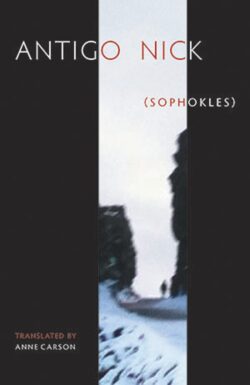
[13] Carson interview with Wachtel, May 2016
[14] Ibid
[15] Ibid
[16] Carson interview with Wachtel, June 2014
[17] Carson interview with Wachtel, May 2016
[18] Ibid
[19] Carson, “The Art of Poetry,” p. 214
[20] Peter Constantine, World Literature Today (January-February 2014), p. 37
[21] Carson interview with Wachtel, May 2016
[22] Carson, Plainwater, p. 29
[23] “Father’s Old Blue Cardigan,” The New Yorker, November 10, 1997, p. 93
[24] Sam Henderson in The New York Times, March 14, 2013
[25] Carson, “The Art of Poetry,” p. 210
[26] Ibid
[27] Carson interview with Wachtel, June 2014
[28] Ibid
[29] Bertrand Russell, Our Knowledge of the External World (London: George, Allen and Unwin, 1914)
[30] Carson interview with Wachtel, June 2014
[31] Carson, Eros the Bittersweet, p. 166
[32] Meghan O’Rourke in The New Yorker, July 5, 2010
[33] Carson, “The Art of Poetry,” p. 200
[34] “Someday Soon,” music and lyrics by Ian Tyson, Vanguard, 1964
8 comments on “1067 The uncertainty of Anne Carson”
Anne Carson is likely autistic. She has said so herself. If you read Autobiography of Red, Geryon has many autistic traits as well. Most likely at the core of her difference – she has and continues to experience the world in a way that is different than neurotypicals. It was so refreshing and validating to find her work.
Great read Bob. And you have made me quite curious. I echo Jordan. A pleasure to read indeed.
Congratulations, Bob. An enjoyable, inspirational, thought-provoking read.
Bob, it’s a great piece! It definitely entices me to read a few more of her books beside Eros the Bittersweet.
It’s been a delightful experience to be able to follow your essay’s development through various drafts over the course of this last year, via our book club.
I wonder if Anne Carson is aware of something Marcel Duchamp said (I don’t know where or when): “I have forced myself to contradict myself in order to avoid conforming to my own tastes.”
Thank you for this good read.
Fine work. Thank you.
Marvellous, polished writing, Bob. A pleasure to read.